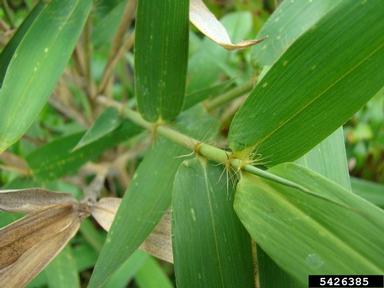Switchcane
Arundinaria gigantea
Family: Poaceae
Natural History

Switchcane in Rocky Bayou State Park, FL
Photo credit: Rebekah D. Wallace, University of Georgia, Bugwood.org
Switchcane is the only native bamboo found in Florida. This erect, perennial bamboo is a large grass that commonly grows between 4 and 20 feet tall. Switchcane spreads by underground stems called rhizomes and is generally found occurring in a dense stand called a canebrake. After growing for decades, this plant will only flower once in its lifetime and then die (called monocarpic). It prefers moist to wet habitats that are shady and requires fire to help maintain a population. In fact, fire may help switchcane flower more rapidly.
Switchcane can grow in various habitats such as pinewoods, hydric hammocks, hardwood forests, along creeks and rivers, swamps, and bottomland hardwood forests. It occurs in the southeastern United States from Florida, west to Texas, north to Kansas, and east to New York. However, canebrake habitats are now critically endangered because they have been decimated to less than 2 percent of their original range.
Canebrakes, a dense stand of switchcane, are important for many species of mammals, birds, reptiles, and invertebrates. It provides food, shelter, and nesting opportunities for many native wildlife species. Currently, there are 6 species of butterflies that rely solely on switchcane for their survival.
Native Americans used switchcane for many various purposes including musical instruments, building material, toys, tools, fuel, candles, and weapons for hunting. Switchcane was also used to help construct houses and to make household materials such as baskets, mats, dishware, and beds. The plant was used for food as it can be ground into flower or used as an herb. Medicinally, it has been used for kidney ailments or for strength renewal. Today, switchcane is used for making fishing poles among other things listed above. It is also used for erosion control and as a buffer in riparian areas as it helps to filter nutrients and sediment from water. Research on propagation of this grass for restoration projects is currently in progress.
